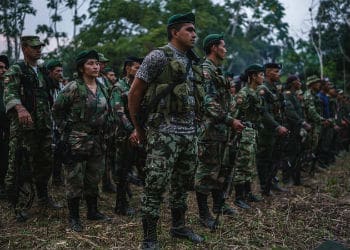August 15 is the final day of the historic disarmament of Colombia’s FARC rebels, paving the way for the next crucial part of the peace process: successfully reintegrating them into society. But the former combatants are vulnerable and tensions are high. Will the government be able to prevent the deterioration of Colombia’s security situation and ensure that demobilized fighters do not return to crime?
Colombian Defense Minister Luis Carlos Villegas announced that August 15 will mark the day when the last of the Revolutionary Armed Forces of Colombia (Fuerzas Armadas Revolucionarias de Colombia – FARC) guerrillas’ personal weapons will be removed from demobilization zones by United Nations staff.
“The FARC disarmament is ending,” Villegas said.
Following the completion of the disarmament stage, former combatants will remain in the temporary demobilization zones, now re-baptized Training and Reincorporation Spaces (Espacios Territoriales de Capacitación y Reincorporación). The collected weapons will be recycled into three pro-peace monuments.
Nevertheless, an unknown number of weapons are still contained in separate storage sites around the country. By late July, the UN had secured less than half of the 779 sites reported at the time by the FARC.
These weapons stores have already been targeted by armed groups. On August 6, a team was ambushed while locating a storage site and a police officer was injured. The perpetrators were believed to be either FARC dissidents or members of the country’s largest active guerrilla group, the National Liberation Army (Ejército de Liberación Nacional – ELN).
Villegas also announced changes in security procedures for the zones.
“The legal framework surrounding [the demobilization] zones is ending … as well as the security scheme for the communities in which they’re located,” he said.
This means that the police will remain in these same areas for the next three years and will be allowed to enter the zones, while the former combatants will no longer be responsible for their own security.
SEE ALSO: Coverage of FARC Peace
Furthermore, as part of a deployment plan announced in 2016, 80,000 military and police troops will maintain their presence in 116 vulnerable municipalities where the FARC used to exercise control.
“This is considered to be the biggest police and military operation in the hemisphere,” the defense minister said.
The next phase of the peace deal will center on the political, social and economic reincorporation of the former rebels, including their transition into a political party.
#VIDEO Así fue el momento en que las armas de #FARC-EP son extraídas del PTN Vidrí #Antioquia hacia bodega central #FinDejaciónDeArmas pic.twitter.com/Vg8NBk5nhs
— Misión ONU Colombia (@MisionONUCol) August 14, 2017
(Courtesy of UN Mission in Colombia)
InSight Crime Analysis
Finally disarmed, the former FARC rebels are more vulnerable than ever. It is largely up to the government to provide what they most need to survive and integrate into civilian life and society in order to dissuade them from falling back into crime.
According to Raúl Rosende, cabinet chief of the UN mission that will continue to monitor the process, “There are two fundamental elements to this end: that the ex-fighters have physical and socio-economic security.”
The importance of providing physical security was illustrated on the eve of the official end of the disarmament phase, when the alleged head of the FARC’s 18th Front militias was assassinated just outside a FARC demobilization camp.
More social leaders are also being killed year on year: another symptom of the FARC’s diminished power and the state’s shortcomings in occupying and bringing protection to the guerrillas’ former turf. On August 6, presumed members of the Urabeños, Colombia’s most powerful criminal organization, assassinated local leader Nidio Dávila, who was actively promoting drug crop substitution in Colombia’s top coca-producing department. This is not the first apparent example of criminal opposition to the coca substitution process.
SEE ALSO: Coverage of Drug Policy
As Dávila’s case shows, these spats of violence may have a direct impact on organized crime. Insecurity will make communities less able to stand up to criminal groups looking to exploit and expand the drug trade, among other illegal industries, which could have severe repercussions on Colombia’s stability and even international relations with key partners like the United States.
Such scenarios also give former rebels and rural communities reason to fear government security efforts will not be sufficient in the imminent future. This could well encourage civilian groups to arm themselves in defense, an option FARC commanders have previously supported.
Still, there have been some advances on the security front, including the strategic deployment of state forces and the approval of a law allowing former FARC members to join a special force of 1,200 security guards (Unidad Nacional de Protección – UNP), which will mainly provide security to former guerrillas.
As the UN’s Rosende pointed out, keeping former rebels committed to the peace process also depends on them making a decent living. Initial efforts to achieve this have been set in motion. Last month, bank accounts were set up for demobilizing guerrillas, and the first monthly sums of money — just below Colombia’s minimum wage (approximately $250) — were paid. Former rebels also launched their first financial cooperative, which will be responsible for disbursing funds to enterprising former fighters. The new Training and Reincorporation Spaces will also see more educational opportunities provided to former fighters, who have already been experimenting with their own business and agricultural projects.

